DAILY MAVERICK 168
Why can’t we live together? The conflict between suburbanites and the homeless in a Johannesburg park
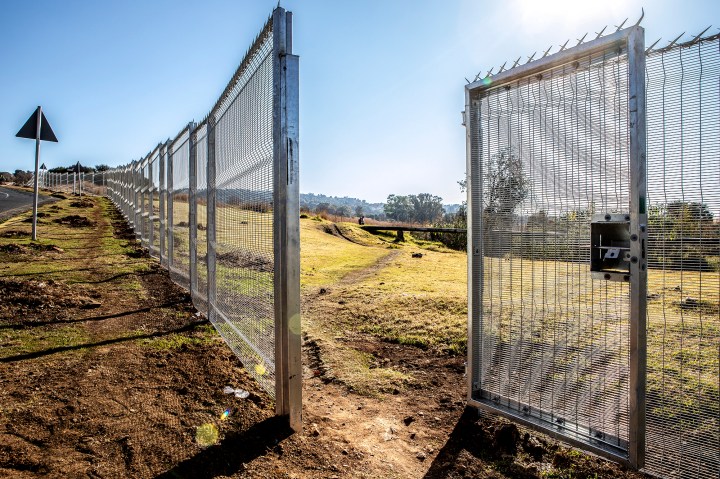
The creation of a R3-million fence around Alberts Farm Conservancy in Johannesburg has scarred relationships among the homeless people who inhabit the park and those more privileged who visit it. Homeless people say the fence will affect their livelihoods while others claim it is not targeted at exclusion, but in fact necessary to protect the park’s natural, valuable assets. What could help is facilitated dialogue.
First published in the Daily Maverick 168 weekly newspaper.
Recently the Alberts Farm Conservancy, a beautiful biodiverse park in Johannesburg’s western suburbs, had a large metal fence erected for three kilometres around its perimeter. The fence, which cost over R3-million, has been welcomed by some and abhorred by others. Daily Maverick tried to understand both sides and see if there is any common ground.
It’s Sunday morning. Almost midwinter. The sky is bright and blue and cold. The sun casts that winter glow that makes the long grasses light up and shine. Small birds chirp furiously and busy themselves with who knows what. In the distance is the sound of church bells. A kitten — strategically placed in the sun — stretches.
It’s idyllic
Joanna* (not her real name) is still in bed. The plastic covering of her chest-high shack has been lifted to let in the sun. Peter* (not his real name) — her companion — busies himself in the “yard”. There are signs of a small fire. In one corner are plastic bottles, other recyclable waste and other detritus that has no value and must be burned or taken to a bin — which, conscious of their habitat, Peter and Joanne boast that they do.
This is Alberts Farm Conservancy, a 45ha oasis in the heart of Johannesburg’s western suburbs. Peter and Joanna are homeless people who say they have lived in the park for more than 10 years.
The beauty that struck me is incidental to them. For them, the nights are cold. In summer, the rains are unforgiving. Water and ablution facilities are hard to come by. They are vulnerable to bullying by Johannesburg Metropolitan Police Department (JMPD) officers or tsotsis.

Long term residents Peter and Joanna on a Sunday morning.
(Photo: Mark Lewis)
Peter and Joanna’s shelter is barely visible to the runners, cyclists and walkers who are taking advantage of this bright Sunday morning. The park dwellers I meet are unobtrusive. Discreet. Dignified. So are the rest of their community, other “homeless” people whose shelters are scattered in different parts of the park. They know each other’s names and occupations.
Public spaces or unwelcome faces?
I live not far from the park. It’s been my sanctuary too. It’s a beautiful spot where I Parkrun and ride. It reminds me that communal public spaces are more important than each of us trying to snare off a little private patch for our own garden.
I could live without a garden if the city has spaces such as these. But recently I’ve been disturbed by the sudden erection of a two-metre metal fence snaking around the whole park. It’s ugly, intrusive and invasive. It triggers subconscious memories of another era in our history when public spaces were fenced and policed.
I want to know who’s behind it, what it’s costing and what it aims to achieve.
As I start my enquiries I meet Tshabalira Lebakeng, a member of the Homeless Writers Project. He has written for Maverick Citizen before about his experience of homelessness. By coincidence last week he interviewed some of the homeless people in the park. So Tshabalira and Matthew T, a “homeless” resident, known by some as “the sheriff”, are here to give Mark Lewis (our photographer) and me a guided tour.
Matthew has lived in the park for a long time. He knows its nooks and crannies, the people who live within it and many of the more privileged who visit it and care for it.
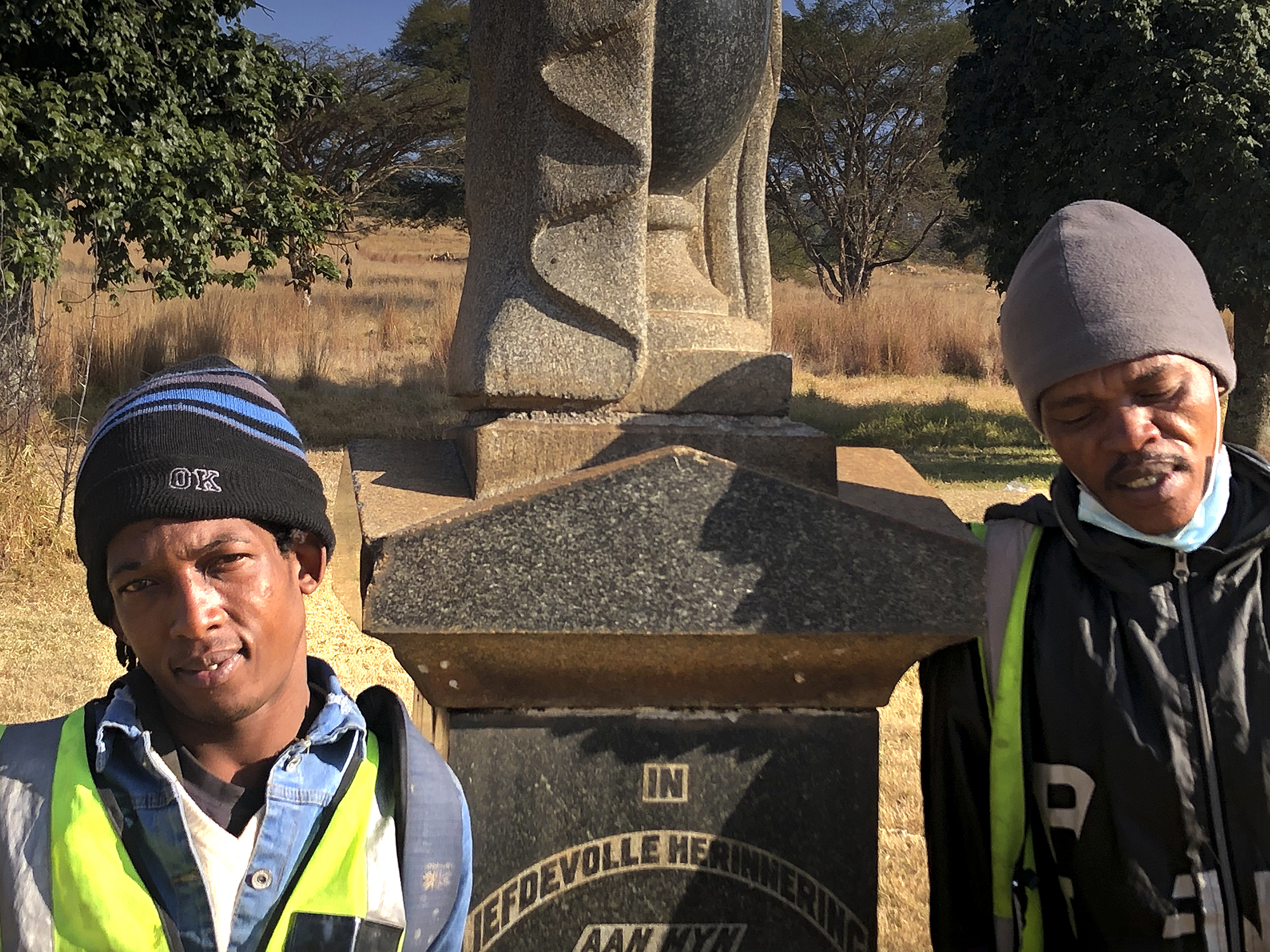
Oscar T and Matthew T, the ‘sheriff’s of Albert’s Farm’ stand beside the gravestones of the Albert’s family, the original owners of the farm. (Photo: Mark Heywood)
He knows where to find the rare birds that live there “but not their names”. He could be a natural history guide; instead, he’s a car guard. That’s how he makes money. Matthew is nervous. He fears that talking to us may cost him his home. He’s a man with dignity and decorum but he’s still scared.
He’s not alone. Later we are joined by Oscar T. Oscar is a little man with a wide grin. He is streetwise beyond his 31 years. He’s the ‘father of the homeless people’ of Alberts Farm Conservancy. He tells me how he moved here from being a car guard at Emmarentia Dam in 2005. When he first arrived the park was neglected and there was “poo all over”.
“I went to my mum and asked her to buy a poop[er]-scooper and started picking it up. Sometimes I was picking up 15 bags a day.” He told me that when asked who had employed him he told local residents he was “doing it for charity”. That was the beginning of a constructive relationship where sometimes he and Matthew would be paid R50 for their help in cleaning the park.
But the fence has soured relations and sown distrust. “When there was no fence they used to greet us like human beings,” says Matthew. The homeless people fear that they are about to experience a secondary homelessness and that the snaking silver metallic fence is aimed at them. Nobody asked their opinions about it, even though they are residents and rights’ bearers in the new South Africa.
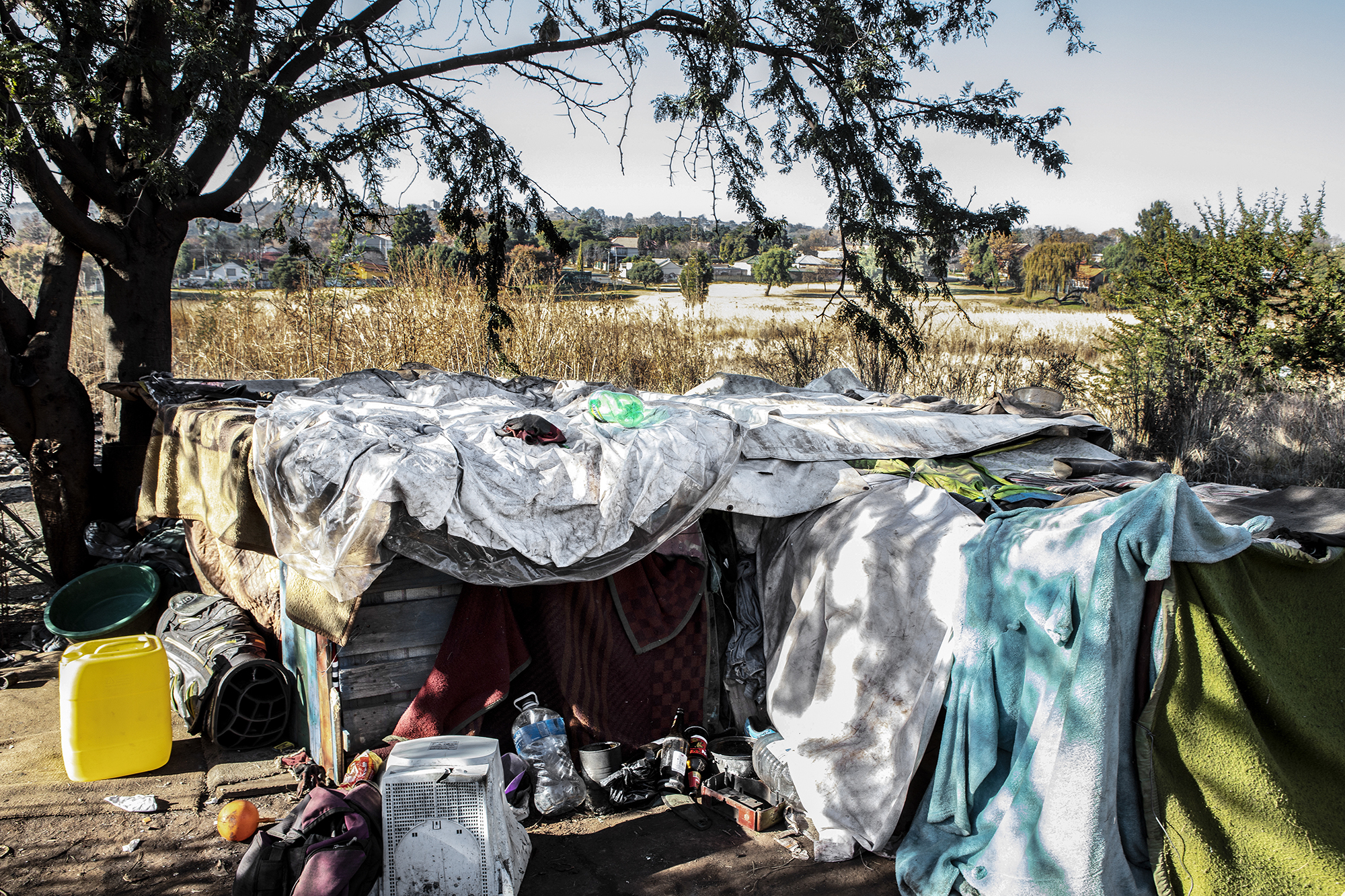
Under the greenwood tree: Matthew and Oscar’s home, out of sight in the middle of Albert’s Farm. (Photo: Mark Lewis)
They say they are not thieves, but “people suspect us because we are trolley pushers”.
The fence is not yet complete. But when it is, the six gates to the once-open park will be locked from 6pm to 6am. The effect of being locked in and/or locked out threatens their precarious living. Waste recyclers have to get up very early in the morning to beat Pikitup Johannesburg to the waste bins so they can sift through precious waste. There is a danger that they will be locked out from another way of making a living because they can’t exit the park early enough.
Associate Professor Sarah Charlton, from the Wits University’s School of Architecture and Planning, has researched “park dwellers, public space and the politics of invisibility in Johannesburg’s northern suburbs” for several years.
She explains that many of the people who live in parks (Alberts Farm Conservancy is by no means unique) do so “to minimise costs of accommodation and transport, respond to cash-flow crises, or prioritise expenditure on family members elsewhere”. She says that “their lives and situation is connected to the economy of the northern suburbs … yet they are frequently dismissed as criminals and vagrants”.
As a result, she explains, they attempt to “evade the censure and punishment of metropolitan police, private security, and those with assumed claims over the public space, through concealment strategies”.
Foes of homeless people?
After talking to Joanna and Peter we cross a bit of veld and bump into Melinda Lotz and a friend. Melinda is a formidable active citizen and deeply involved in Friends of Alberts Farm. I ask her if we can talk to her and she willingly agrees. But when I tell her I want to talk about the fence her friend erupts in a tirade of abuse.
“If you don’t have this fence you will have a township in 10 years,” she screams at me. I ask her name and she shouts: “My name is f**k off.”
With her foul-mouthed friend out of the way, Melinda is keen to explain. She and other activists have invested deeply in protecting and improving the park. “Twenty years have gone into fixing it,” she says. They genuinely care about preserving this little wonderland. And that’s great. She scoffs at my naivety when I suggest that ways could be found to accommodate homeless people.
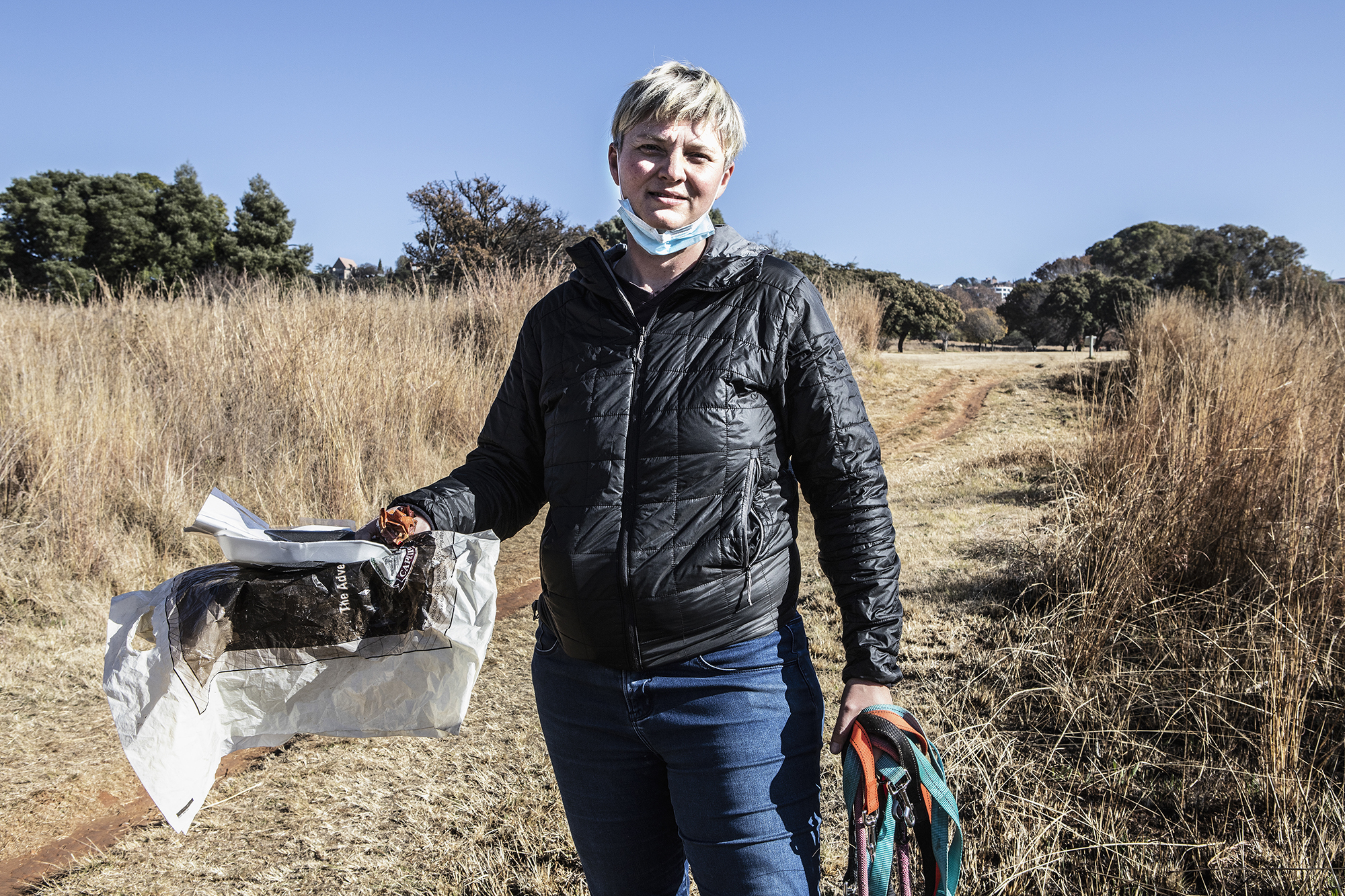
Sunday morning stroll and clean up: Melinda Lotz, an activist of Friends of Albert’s Farm, says there is no intention to evict the people who live in the park. (Photo: Mark Lewis)
“Why don’t they go to a shelter?” she asks.
She complains bitterly about religious gatherings that often take place in the park: “they” burn candles that destroy trees, “they” break glass bottles and “they” even have public sex. “They” is a term laden with the othering of black people.
However, all the white people I speak to insist they are not racists. Yet I wonder about their double standards. And their failure to spot their own intimidating power and privilege.
Why is it that mountain bikers careering through the park, scouring and eroding parts of the landscape are acceptable, but religious gatherings are not? If there can be rules for how mountain bikers use the park (which they mostly abide by), why not rules for the faithful?
I put these questions to Jane Eagle, Deputy Director of the Open Space Planning, Water and Biodiversity Directorate at the City of Johannesburg. She referred me to Johannesburg City Parks and Zoo (JCPZ), who are categorical in their response.
“The fencing is not targeted at exclusion of the homeless people who live within the park and is not designed to trigger any evictions. Homeless people continue to live in many of the city’s fenced parks. Any operations which JCPZ or JMPD may conduct as part of their normal by-law enforcement functions in the city’s many public open spaces, would be entirely separate and not due to the fencing.”
JCPZ say the fence has cost approximately R3-million and was properly tendered for. Eagle says the fence is necessary to protect valuable natural assets; it is a “vulnerable open space”; it has “amazing hydrology”; “it’s fenced for the same reason we fenced Melville Koppies [Nature Reserve]”. However, JCPZ say there is “no policy to fence all public parks or conservation areas”.

Michael M who has lived in the park for 12 years, his shelter hidden in the grasses of the wetland. (Photo: Mark Lewis)
When I first thought about writing about the enclosure of Alberts Farm Conservancy I thought this article would be pure denunciation and outrage. But I realised as I spoke to the stakeholders that it’s more complicated than that. Each misunderstands and fears the other. The powerful make assumptions about the poor. And whether they admit it or not, their assumptions are often tinged with racism or classism.
Instead of the campaign to preserve a beautiful park being a way in which we can find and discover each other, overcome our prejudices, it becomes a driver of division and ultimately the replication of exclusion. I wonder aloud: “Why were less-restrictive means than a fence not found?”
Tshabalira’s answer says it all: “They are two communities in one place when they should be one community.”
As I walked out of the park that morning a song floated into my head, Why can’t we live together?, originally by Timmy Thomas, later redone and made more famous by Sade:
“Tell me why, tell me why, tell me why
Why can’t we live together?
No matter, no matter what colour
You’re still my brother
Everybody wants to live together.”
It’s not too late. The homeless people of Alberts Farm Conservancy are fearful. They fear that talking to me is going to increase their vulnerability.
Charlton says that what would help now is a facilitated dialogue and interaction between all the park’s stakeholders, combined with some practical interventions like building and maintaining public toilets.
So, there is a way to bridge the fence. But at this moment the onus is on the homeful people to prove the homeless people’s fears are wrong.
Then maybe when trust is built the fence can be taken down and recycled for better uses, like building houses. DM
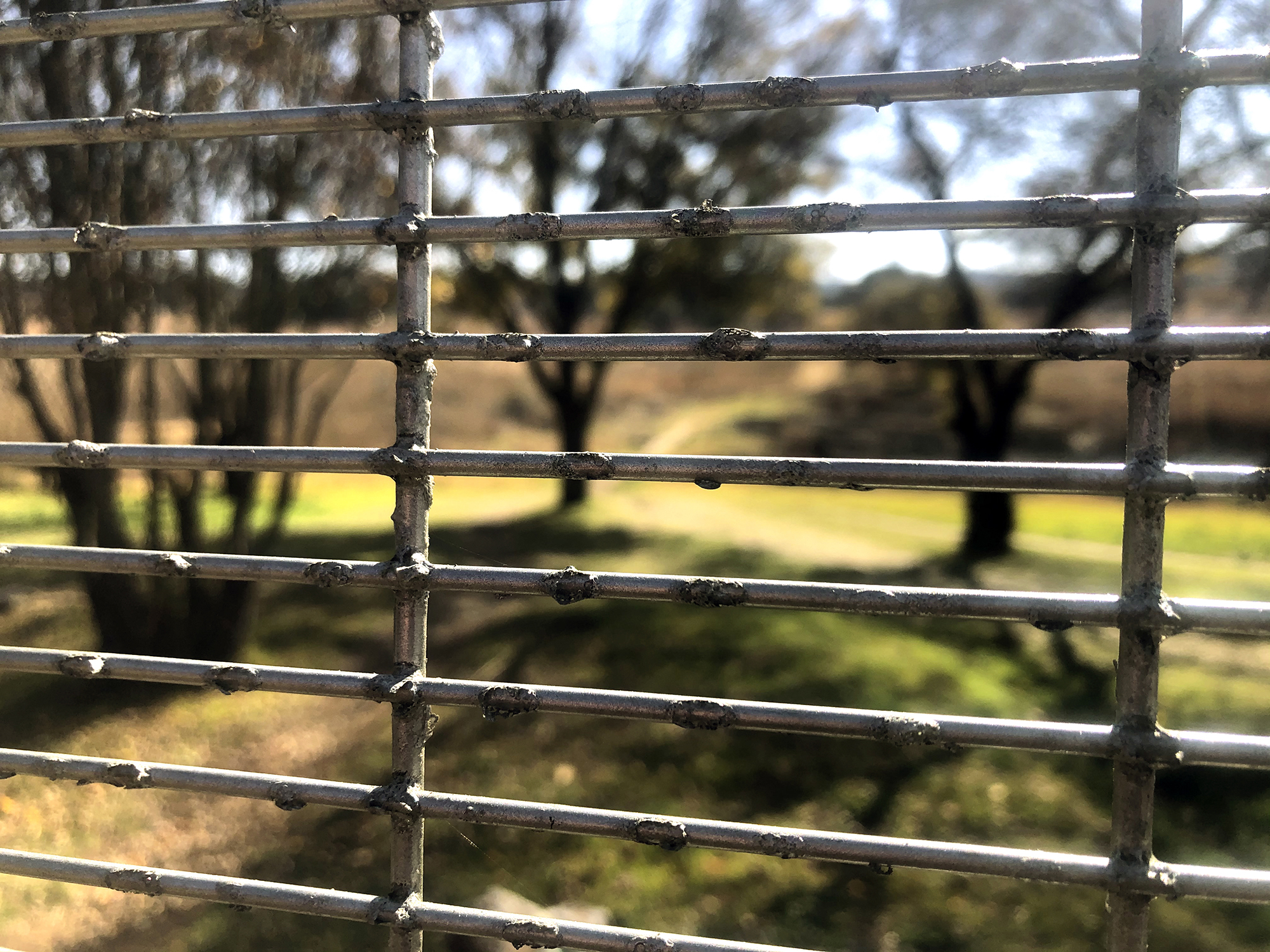
Fenced in: the park is now enclosed behind a three km fence with six gates that will be locked at night. (Photo: Mark Heywood)
This story first appeared in our weekly Daily Maverick 168 newspaper which is available for free to Pick n Pay Smart Shoppers at these Pick n Pay stores.
Sidebar: The homeless people of Alberts Farm Conservancy open up about the challenges of living outdoors and why they would rather stay in the park than in a shelter
Alberts Farm Conservancy in Johannesburg’s western suburbs is a place of outstanding natural beauty and peace. It’s also a place where, over the years, a number of people have made homes to shelter from unemployment, Covid-19 and homelessness, and to be closer to economic opportunity. Tshabalira Lebakeng from the Homeless Writers Project interviewed some of them.
Mr M from Emnambithi, KwaZulu-Natal
“I was working in construction. But since corona I lost my job. I didn’t have a place to stay after I lost my job. This park [has] friendly people and it’s clean. I don’t remember being treated badly. What I don’t like about it [is] people coming here at night abusing us and burning our stuff.
“I like the animals in the park. One day I saw a rabbit but I didn’t kill it. It’s because it’s nature. Some of the people [have never seen] a rabbit before. I don’t want to stop them from seeing animals by killing them. Because my tent is up on the mountain I have a chance to see every beauty of the park. I cook here but I make sure I don’t burn the mountain.
“Last year at Level 5, when the corona thing was starting, the government took us to different homes. It was good for me to have a shelter because I didn’t know what corona was. I didn’t want to die and leave my kids in this horrible world. But after days in that shelter, they started to not give us food. [We were] maybe eating once a day. Sometimes the water was cold. Here I [boil] water before I bath. Another thing [is that] they didn’t give us a chance to go out and make money. I told myself there is no life in the shelter.”
Pert K
“I’m from Chiawelo, Soweto. I have five years living in the park. I was painting houses around here but after corona [no one] is allowed to enter houses. I didn’t want my father to see me like this. My life, it’s in the park now. I did have a place to stay but when I lost my job I couldn’t pay rent, so this is my home. I make money by recycling.
“The people who are coming to visit here are friendly and give us food when they don’t eat. [In summer] there are lots of parties and picnics. It’s when I’m getting more rubbish to sell.
“What I don’t like about the park is the JMPD [Johannesburg Metropolitan Police Department] because they hunt us like animals. They come at night and harass us like dogs. One of the police took my money and he told me, ‘It’s stolen money.’ Church people, they come here and swim in the dam and leave their clothing around. They don’t clean [up] after they are done doing their thing.
“Another thing [is] this fence they are building. They will close us outside. We won’t be able to access the tap water and our tents. We have to move now. I don’t know where. They say they put this fence [up] because we are robbing people here.
“We don’t do those things of robbing, we just stay here and sleep only.
“I don’t want to stay at the shelter. I don’t want to be like a farm animal. I once stayed in the shelter but [it] was not good. You go out in the morning [and] you later find the doors are locked. If I can have a job and a place to stay I will be okay. Staying here [is] peaceful. I like to drink the holy water at the mountain and pray in my secret place.”
Dizaya from Zimbabwe
“I’m Dizaya from Zimbabwe. I have three years in South Africa. I was working in construction. After that company finished their work I didn’t have any job. I’m good at painting and building houses. But most of the time I’m selling scrap. Now that they are closing the park by putting up this fence I don’t know where I will put my things.
“It will be more difficult for me to be safe if I move from here. People don’t like people from Zimbabwe. Here it’s safer because people who are staying here don’t fight with me.
“What I like about this park is its peace. People are friendly and caring; this jacket I got yesterday from my white lady. She found me freezing there by the gate and she gave me her jacket. I didn’t believe it.
“When I’m not going to recycle I just sleep in the sun. [No one] will come and tell me to go away. What I don’t like about the park is people who are coming here and robbing the good people. At the end of the day, we who are sleeping here get in trouble.”
Peter M and Joanna
“I’m Peter from Rustenburg and this is Joanna, from Kuruman.
“It’s been 20 years [I’ve been] staying here. It was a dirty park and they didn’t maintain it very well. One day me and Joanna were sitting by the gate of the park without luggage. A lady by the name of Judy asked us if we want to stay in the park but we will help by cleaning it. It was our first time living here. We cleaned the park every day. Judy gave us food and blankets.
“Other members of the community were not happy, but there was nothing we could do because we are homeless.
“There is no privacy here. Anytime someone can come and tell us to go at night. Some of them come in the morning and kick our tents away. They tell us they pay tax for this park so they have a right to kick us out.
“Yes, now we are in numbers in the park but most of the time I’m with Joanna. What I like about this park [is its] holy water. We drink it every morning and before we go to sleep. We see people travelling from far to fetch this water, so we have hope in it.
“When I want to bathe I [boil] water on [the] fire. If I want to go to the toilet I go down in the bush. If we can get help with toilets and bathing places; we don’t like to be looking like this.
“We did go to stay at the shelter but no, no, that place has too many instructions like prison. You have to come in on time or you will sleep out.
“This fence now will make my life a living hell. I don’t know why they [are] kicking us out. Because we don’t do wrong, we just sleep and go in the morning to make money. It will be difficult to get another place. JMPD and other securities come at night in big numbers because they say we are criminals. But since the lockdown they [haven’t] come.” DM
This story first appeared in our weekly Daily Maverick 168 newspaper which is available for free to Pick n Pay Smart Shoppers at these Pick n Pay stores.




















 Become an Insider
Become an Insider
““They” is a term laden with the othering of black people.”
Mark, why are you subtly trying to put words into her mouth and racially charge this piece? You asked her about the homeless people and she explained her views on the homeless.
While poverty is overwhelmingly black in this country, and there may be spots of classism, you shouldn’t leap on it being a racial issue unless you can prove that it is.
Agree, the abhorrent characterisation of Ms Lotz is disgusting.. This is a classic leftist tactic: Cast a person as “privileged” in an attempt to somehow invalidate their view/opinion. Notice how the author doesn’t address the issues she raised other than a weak deflection to mountain bikers riding on dirt paths, unbelievable. We are now at the point where if you visit a park, you are “privileged” and must shut up, check this so-called privilege and simply accept the decay and illegal activity going on. Avoid the emotive angle that makes you feel good and focus on what actually does good..
If you take away the sentiment isn’t it perfectly obvious why the suburbanites ( more usually called rate payers) want separation from those living roughly in a public amenity, where they bathe and defecate. There is a certainly a homeless problem which is the responsibility of the authorities, but the solution shouldn’t inpact on the rights of others or conflict with civilized by laws nor should the homeless have a veto on any solution offered.
Finding it very hard not to see certain biases in this piece??
I live on the farm and hate the fence, though it does protect the farm from dumping, not people who live inside but probably suburban people who dump their waste. There are lots of people who care for and look after Albert’s Farm including those who live there.
I think it was remiss of the journalist not to talk to the active & concerned committe members of the Alberts Farm Conservancy.
Didn’t suit his narrative. Left wing writers are about narrative and boy, am I sick of it.
hear hear…
Maybe a further investigation into the outsiders mentioned who come and rob? What is the police angle? Should parks be accommodation for the needy? Can they be pristine reserves for occasional users? All of those people you met seemed united in liking the park for its peace beauty and water. But surely it can’t last if anyone can just go live there or just decided to grow veggies, sort junk or whatever they need to do? It’s the bigger picture of housing, safety in poor areas and transport which needs attention.
I must take issue with this very one-sided article. While I have deep sympathy for the homeless I have watched the destruction of the natural park and waterway behind my home over the past ten years as vagrants litter, defecate in it, chop down trees and burn it down. No one walks in the beautiful park anymore and crime has rocketed and has been directly linked to vagrants in the the park. House prices have plunged. The homeless problem is not solved by allowing the destruction of green spaces and curtailing other citizens rights to clean, safe recreational spaces.
A bit one-sided Mark, and a very simplistic approach to a very complex issue. Homelessness is the actual issue here – not the homeless themselves, but the way authorities deal with it; and homelessness is the result of unemployment, generally. The cops, themselves mainly black, treat our most vulnerable people with utter disdain, and the alternatives, ie the shelters, provide a temporary accommodation, with the implication that the homeless situation is also temporary, which it is not. The chances of these people digging themselves out of their hole is zero. It is not really acceptable for people to live in a public park, and it is the responsibility of the authorities to provide a viable alternative. Why not take issue with them? Then there is also the SoD regulations which protect occupiers of land, provided they already live there. In Cape Town hundreds of people live everywhere, even between lanes on the N1, and this untenable situation continues because the City is not willing or cannot provide an acceptable alternative. It is also typical that one settled tent or plastic shack attracts another, and within days there are a dozen or more. It is quite irresponsible to think that anybody can live anywhere. Which city in the world will tolerate that? Which community will tolerate that? Our government – local, provincial and national – is delinquent, and unwilling rather than incapable, of solving these problems. Writing biased opinion pieces will not solve this problem.
I live a few blocks away from the park and was unhappy to see the fence going up. I had no idea it was in the works until construction began, but for years have heard people in the area complaining about the homeless in the park, and they most certainly are racist. They would get excited about their raids to tear down ‘illegal’ shacks, full of their ‘they’ and ‘them’ bull. I don’t understand what the fence is supposed to be doing. How is it protecting these valuable natural resources? Do bad things only happen to our valuable natural resources when it’s dark? I wish people were kinder. How can people with so much be so hateful and close-minded? Perhaps there are good reasons for the fence, but I haven’t heard them yet. And Melville Koppies is a TERRIBLE example; that fence has been worse than useless!
For those with good intentions, I was, however, very appreciative of the efforts (and I’m sure huge amount of money) being put into repairing the dam.
” I too live close by. We have enjoyed a few Sunday morning walks there particularly through some stages of lock down . The homeless people have never detracted from this unique park experience.. I can’t think what JCPZ were thinking … the fence is abhorrent & totally unacceptable. I hope it gets taken down!
No balance what so ever…whether it’s reporting the homeless in CPT or any where else. But thats what activists do, ignore anything that doesn’t fit into their narrative.
“Why can’t we live together?”
Mainly because of biased drivel laden with “unnecessary” punctuation and utterly inaccurate racial conclusions. Hey Mark Haywood, woke fools like you have done more damage to racial harmony than any group of people in recent history. Stop turning the world into a mirror of your own self loathing.
OK so Mark is “woke” but you are indeed the fool.